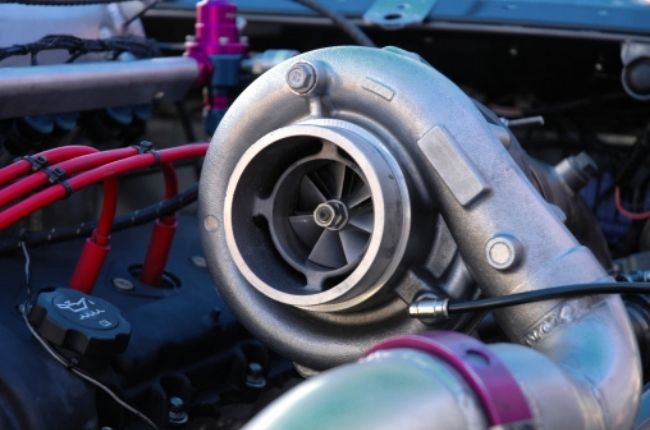
Turbocharged engines are becoming more and more common in cars today. We see them on everything from compact sedans like the Nissan Almera's 1.0-liter turbo mill or mid-size SUVs like the Ford Everest's 2.0-liter bi-turbo power plant.
Whichever car you find them in, you're bound to experience turbo lag on a turbocharged engine. While it's a normal phenomenon, you may be wondering what turbo lag is, why it matters, and whether you can eliminate it. We're here to answer that and more.
What is a turbocharged engine?

A good understanding of turbo lag involves learning how turbocharged engines differ from their non-turbo counterparts. A turbocharger is an additional component of an internal combustion engine. It's composed of a turbine and an air compressor that harnesses extra compressed air into the combustion chamber. When more air enters the cylinders, this increases the engine's power output.
Whereas turbocharged engines limit wasted air, naturally aspirated power plants use natural air pressure to push air into the engine. Turbo engines differ in that it speeds up the air intake process to produce more power efficiently.
What is turbo lag?
Turbo lag can be defined as a delayed response when you hit the throttle of a turbocharged car. The engine needs time to respond to throttle changes, and the driver may experience turbo lag as a slight hesitation on the engine's part. That is because the engine needs to produce enough exhaust pressure to spin the turbine and force compressed intake air unto itself.
Turbochargers activate on specifically tuned RPM ranges. When hitting the throttle from idle, you may not experience an immediate torque boost. That's turbo lag, and it's normal. Step on the gas further, and you'll find that the engine gives a noticeable power boost.
However, most modern turbochargers are not as prone to lag. Given newer technologies, lag time is reduced and a twin-turbo setup is no longer a necessity for high-performance cars to mitigate turbo lag. Also, for turbos with twin-scroll technology allows the impeller to get up to speed quicker and produces boost at a faster rate. Also given modern tuning, it’s not as big of an issue compared to before.
Can I reduce turbo lag?

There are several ways to reduce turbo lag, and not all of them are recommended for the average car owner. If you're determined to do so, you can look at things like narrowing the turbocharger powerband, adding a wastegate, or even installing a nitrous oxide setup.
The above methods can reduce turbo lag but are decidedly dangerous for anyone who doesn't know what they're doing. If you're looking to reduce lag on your turbocharged car, it may be best to consult a professional to know your best options.
A note on twin-turbo setups
Some turbocharged engines feature two turbos working in tandem with one another. You can find these on bi-turbo or twin-turbo diesel models like on the Ford Ranger and Everest. The engines on these vehicles tend to have reduced turbo lag due to the layout of the turbocharger. With these engines, a smaller turbo services the lower RPM ranges while a second turbo takes the reins when the engine gets higher in the RPM range. So, if minimal turbo lag is a priority for you, it may be worth taking a look at cars with sequential turbos.
Other performance cars use twin turbos in a parallel setup. This means that the two turbos activate at about the same time. Unlike sequential systems, parallel turbochargers can offer more power but don't affect lag as much.
Conclusion
Turbo lag is a normal hesitation when hitting the throttle on a turbocharged car. This delay is a small compromise when considering the significant power boost a turbo system provides. While there are ways to reduce turbo lag, these methods are generally best left to professionals and enthusiasts.
Latest Features
-
An all-electric future: The Porsche Macan Electric / Featured Article
Porsche’s Macan goes all-electric; it’s a new beast with an electrified heart, yet unmistakably Porsche in performance and spirit.
-
Which Kia should I buy? / Featured Article
We’re here to help you decide which Kia vehicle is best for you, whether it’s a sedan, crossover, or minivan.
-
Why Lynk & Co is a good option for luxury car buyers / Featured Article
Lynk & Co offers premium value for those exploring the luxury market.
Popular Articles
-
Electric Vehicles in the Philippines for under P1 million
Jerome Tresvalles · Aug 19, 2025
-
Top 3 Cars For Every Lifestyle—What Cars Are Right For You? | Behind a Desk
Caco Tirona · Apr 24, 2024
-
5 Tips to Maximize Fuel Efficiency
Jerome Tresvalles · Sep 09, 2024
-
Five driving habits that are draining your fuel tank
Jerome Tresvalles · Jun 24, 2025
-
Can engine braking harm your engine?
Jerome Tresvalles · Sep 11, 2025
-
Do electric cars even need maintenance?
Jerome Tresvalles · Oct 23, 2024
-
Best vehicles for an active outdoor lifestyle
Shaynah Miranda · Jul 25, 2024
-
How to drive different types of vehicle transmissions
May 23, 2024
-
5 easy ways to keep your car interior clean
Allysa Mae Zulueta · Nov 15, 2021
-
How to survive Metro Manila traffic
Earl Lee · Aug 16, 2022



